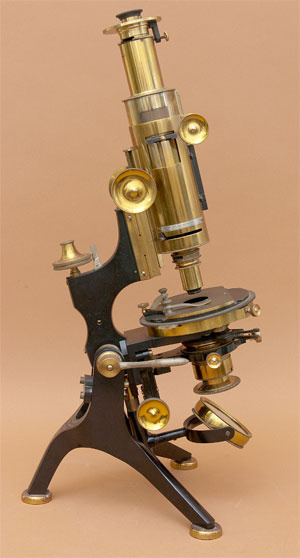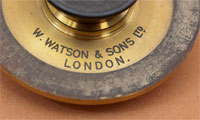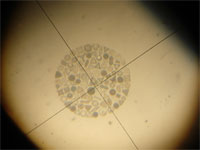 |
|||||
 |
 |
||||
 |
|||||
 |
 |
||||
W. Watson & Sons of London Polarized Light Microscope (No. 154) |
||||||
 |
Age: c. 1890 Made by: Watson & Sons Made in: England |
|||||
 |
||||||
|
Signatures
|
||||||
 |
||||||
|
Imaging
|
||||||
|
This polarized light compound microscope was made by the optical firm of W. Watson & Sons of London according to the design requested by Dr. Henri Van Heurck, Professor of Botany in Antwerp. According to Van Heurck, ". . . we have endeavored to combine convenience for ordinary work, with the utmost possible precision, at a comparatively low price." It sold for 15 English pounds. It is a compound monocular microscope mounted on a very sturdy tripod base. Each leg having a circular brass disk at the foot. The stand has a compass joint and tightening lever to allow the microscope to tilt to any angle. The top portion of the stand contains a short lever fine focus mechanism that is actuated by a graduated knob. Coarse focus is via a rack & pinion mechanism actuated by a brass knob. The rack gear is attached to the body tube. Inserted into the body tube is the microscope draw tube. it also has a rack & pinion mechanism for drawing it in or out of the body. There are cutouts in both the body and draw tubes to allow access to an aperture/accessory lens slider. At the base of the body tube, just above the insertion of the objective is a third Nicol prism that can be rotated through 90° via a small lever on the side. The stage is circular and allows rotation of the sample. It is graduated in degrees and has a Vernier for fine measurements. Under the stage is the condenser. It is mounted on a carrier and can be focused independently. There are two top lenses that can be rotated into the optical path. At the base of the condenser is the Nicol prism polarizer. It also can be precisely positioned via graduations. The mirror is mounted to a pillar descending below the stage. The microscope optics consist of a 2in. objective lens that screws into a slotted mount and a two-lens Huygenian eyepiece. There is one additional lens fitted to a slider. It is positioned well up into the drawtube. This instrument is engraved in three places: The back of the base, the circular analyzer, and the objective. The single objective was manufactured by Ross. Imaging is fairly good, showing no chromatic aberration. The Nicol polarizers are still effective in creating a polarized dark field. The microscope is 47cm tall. This instrument is described in detail in Van Heurck's book, The Microscope (English edition published in 1893), along with a precise full-page engraving of the microscope. It is signed W. Watson & Sons, London, and has the serial number of 24816. It can be estimated as having been made in the period between 1890-1906 since this design was continued relatively unchanged for a number of years. According to the Watson catalog of that period, it was their most popular microscope. Microscope featured 12/2003; 08/2016 |
||||||